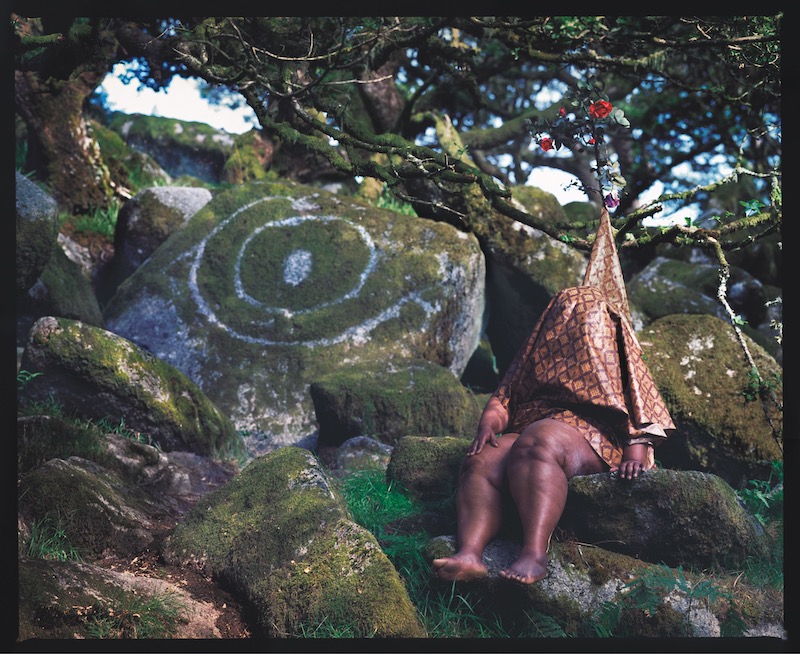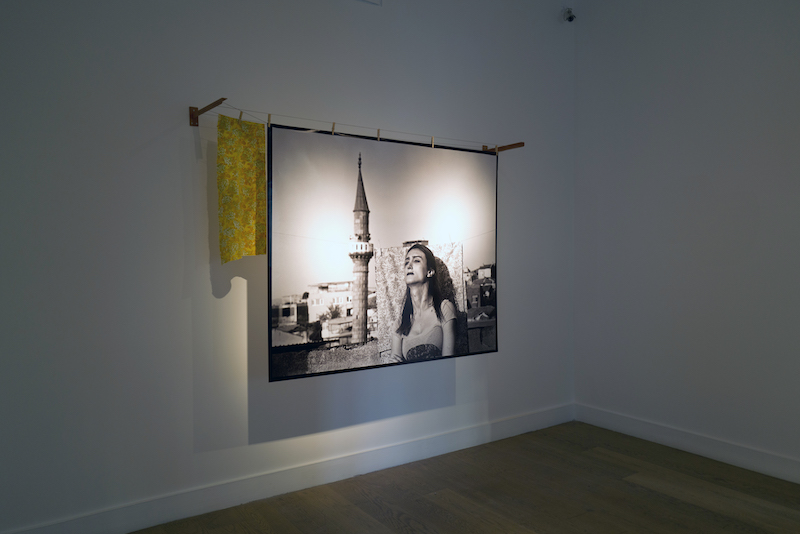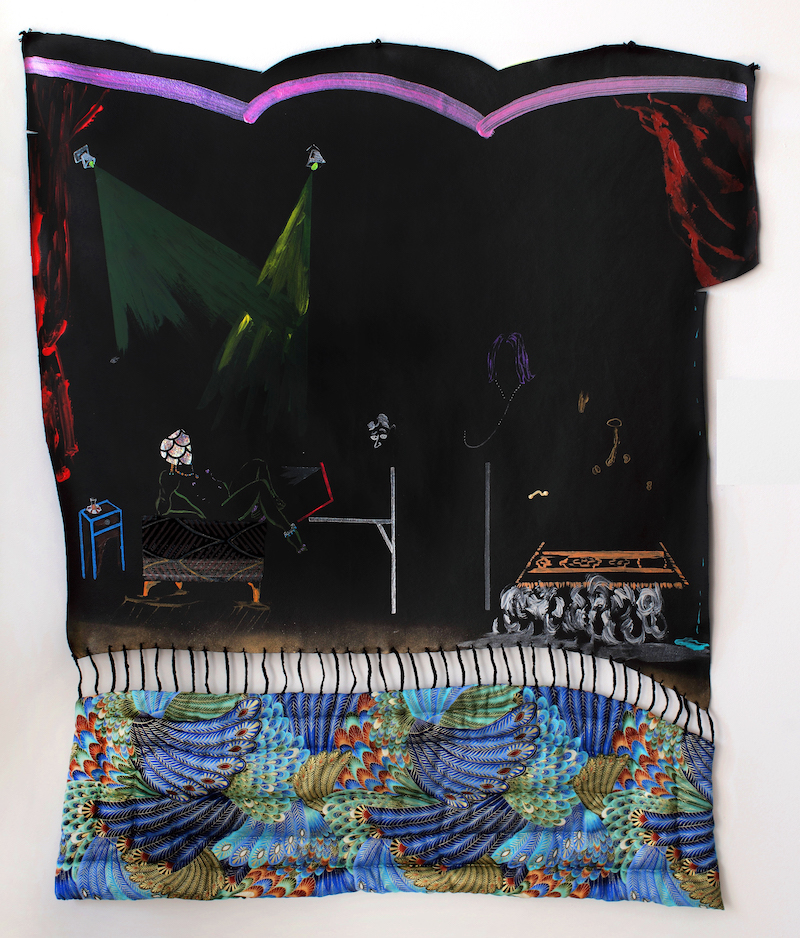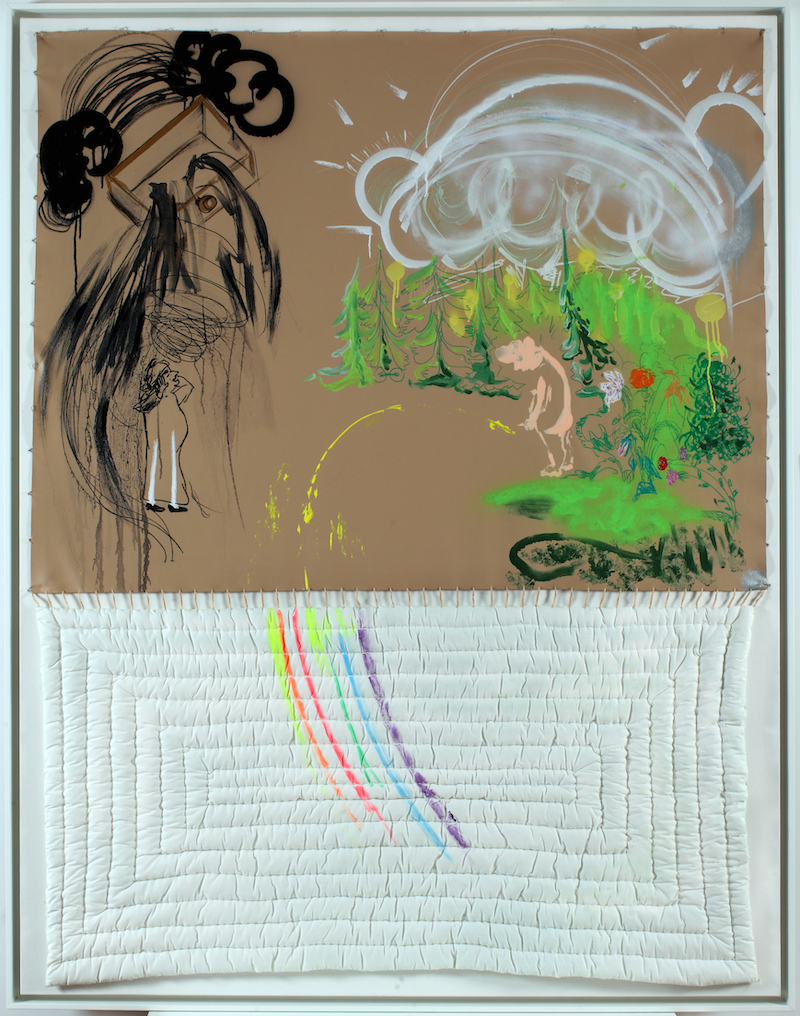Together with the opening of the 16th Istanbul Biennial and the Arter’s new contemporary art museum building, Istanbul becomes a pool of surprising encounters from the month of September. Located right next to one of the biennial venues, Galerist is currently hosting a solo exhibition with Vienna-based artist Nilbar Güreş, while using its location to create a blissful gap to think and fluid the terms, concepts and ideas that are commonly presented in the biennial and its side events. I have talked to the exhibition’s curator Kevser Güler and the artist Nilbar Güreş about the urgency of this collaboration, the depth of Güreş’s recent works and the need of the discussions around transfeminism that shines through her practice. “Although the sky gets dark time and again, Magnet and the Moon calls us to remember the horizon of pleasure,” says curator Güler about Güreş’s show –– and we enter the horizon willingly more than ever.
Mine Kaplangı: This is such an exciting collaboration! I have been following both of your work for a long time and I’m thrilled to watch this companionship grow. May I ask how this collaboration came about? How did you both prepare for this exhibition?
Nilbar Güreş: Thank you so much dear Mine, I am very glad for having this conversation with you, with someone who understands us and is sensitive towards similar issues. I met Kevser during the 2009 İstanbul Biennial, curated by the collective What, How & For Whom. I had the pleasure of working with Kevser in 2015 when she and Fulya Erdemci curated the first exhibition at Cappadox Festival. I have twice shown site-specific works at Cappadox. From time to time in such processes that develop spontaneously or in exhibitions, like the biennial, that has a deadline; every new production necessitates physical and mental strength. In my opinion, both Kevser and I know each other in the most difficult moments, and in time this knowledge turns into a relationship of rapprochement and trust. Dear Kevser, first of all, is a sensitive individual as well as someone I admire vision, taste, and writings of. Kevser has a nature that stimulates and nurtures her artist with that transparent, full language found on literature. Every time she writes for me, she puts my works into words and revives me. This year, upon her invitation, she and I had the opportunity to work together in the exhibition titled ‘Flesh and Bone’ in the Operation Room, the exhibition hall of the American Hospital. Once again, I was convinced how much we spoke the same language, how effortless and productive we were. Kevser does not impose anything to her artists, does not force, drag, pressure and never loses the grip on her humanitarian nature. I care very much about these conditions and characteristics. These are the features that are not found in today's rotten art world, which is managed by power battles, not the quality of work. I believe the process towards the exhibition was both fast and slow simultaneously. People who follow each other sincerely work fast together, but we have prepared remarkably for Istanbul. I actually have more than 10 international exhibitions annually and recently solo exhibitions abroad have started to come up more frequently. But somehow I couldn't exhibit the same intensity in Istanbul and this affects the narrative of the exhibition. There are many works that are related to one another, thus we posed ourselves in this exhibition: how? Through which story? And what relations? Maybe traced.
Kevser Güler: Dearest Mine, I also thank you very much. It's a pleasure having conversations with you on exhibitions. I accepted the curatorial responsibilities of "Magnet and Moon" upon the invitation of Nilbar with joy. I have been following Nilbar’s practice for more than ten years. I was sure that she was one of the most exciting artists for me. Thinking together, discovering Nilbar’s works and forms has always been something that I am delighted with. Moreover, I was always impressed by the intensity of her production processes, and the openness, generosity, passion, and seriousness of her thought and insistence in pursuit of forms. The transformation of an idea, a gesture, a material, or an object into a work of art is fascinating. For each of her works, Nilbar is interested with dedication in articulation processes of forms, and she looks at the meanings, forms, and politics of this articulation, covering the surfaces, traversing the layers and depths of these.
When we started thinking about this exhibition, in fact, from the first moment I wanted to exhibit works of Nilbar that have never been shown in Turkey. In recent years, Nilbar has participated in many group exhibitions, but also there were solo exhibitions that she made in institutions abroad. The works produced in these processes have not been seen in Turkey. Taking into account the constraints of the exhibition space, I made a selection of these works and I imagined this exhibition would allow a sharing of different moments, medium and forms of her production in recent years. Moreover, she produced new works for this exhibition.

Nilbar Güreş "Underneath", 2019 © The Artist; photo © Reha Arcan
NG: Badischer Kunstverein is a wonderful place with its 200 years of history and its unique architecture. We also worked with my beloved director Anja Cassner in a group exhibition a few years ago –– so she knows and follows me. These two exhibitions (Baden and Istanbul) are two completely separate exhibitions, but of course, they hold hands over the works. There, dear Anja Cassner selected works from both the past years and the recent period and opened it in a spacious way. I think the Badischer Kunstverein exhibition, offered through possibilities of their spatial diameter and because Anja Cassner chose a wide spectrum of my work, introduced me deeply to Germany and I feel thoroughly thankful to her for it. The Galerist exhibition, similar to the Badischer Kunstverein exhibition, features works that span a wide period of time.
"Magnet and Moon" is a work produced for the exhibition and I already sense that this work is a new form for me and will lead to a new era. Both the work and its name came into being at the first meeting we had. This is the hope that the act of producing art, can get away from those soulless conditions that it has been exposed to and instead can get into a real environment. On the other hand, the superficial work patterns of artists with tight deadlines and necessitating speed result in copies and the ignorance that cannot distinguish the replica from the artist bother me. Although many artists don't care, I take care not to be in the same exhibition as the artists who copy my works. In time, I became better in determining that I would never work with some people I had worked with before, or that I could work with some people at all or at least with confidence. Over the years I've realized that partnerships that are not based on cheap personal interests and ambitions are timeless.
MK: Nilbar, you are known mostly for your photography-based works. But in this exhibition there are various media, such as video installations, collages, paintings, sculptures and drawings connected to each other. Kevser, how would you describe her artistic practice?
KG: This was something I especially considered when I was making the selection. As I worked closely with Nilbar, in addition to her photographs and paintings, I discovered the power of her video pieces, sculptures, and site-specific installations. It was striking for me to see Nilbar's relationship with space, both exhibition space and geography, and moreover, with research. Instead of being drawn to the narrative aspects of an issue, Nilbar sees the formal particularities of it. I find this very rare. For me, Nilbar's productions have long been encompassing various media. Encountering the figures and acts that lead to video pieces from her paintings, and from her videos into her photographs, gives me great pleasure.
 Nilbar Güreş "The Eye", 2018 © The Artist; photo © Reha Arcan
Nilbar Güreş "The Eye", 2018 © The Artist; photo © Reha Arcan
 Nilbar Güreş "The Eye", 2018 © The Artist; photo © Reha Arcan
Nilbar Güreş "The Eye", 2018 © The Artist; photo © Reha Arcan
MK: Nilbar, your work reveals quite a few symbols, forms, stories and various expressions. This intense all-togetherness is a continuum in your practice that requires a great amount of patience, attention and desire. It’s almost a manifestation that they can all coexist. Kevser, may I ask you how “The Magnet and The Moon” exhibition manifests itself to the audience?
KG: From the very beginning, I’ve been happy thinking “Magnet and the Moon” as an exhibition presenting the viewer with Nilbar’s recent concentrations, trans-formations and explorations. I believe it is also significant for an artist’s practice that hasn’t exhibited solo in Istanbul for quite a while. The subjects of gendered bodies, their social and contemporary representations, political and figurative power of queer and transfeminist imagery are brought together through various questions – questions of naturalism and essentialism; representations of earth, and definition of the body through colonialism. Nilbar focuses on the multi-layeredness of covering and revealing; the double meaning attributed to the cloth as both protective and also as oppressive. "Bush" (2019) provides a reading of body hair and its primal representations and "The Eye" (2018) tackles the covers of invasion and colonialism, as well as "TORN" (2018) of the destructive and denying covers of sexism and gender dis-equalities of public space. In Nilbar’s Works, covering and uncovering are strong gestures –– both aesthetically and politically. I think another strong channel in her earlier practice is the various ways in which she engages in desire; I feel that the figures’ acts start with an active inclination of desire in Nilbar’s scapes. Desire – written by sexual difference but not only about sexuality– is so present in this exhibition in Nilbar’s performative paintings and staged photographs and installations.

Nilbar Güreş "TORN", 2018 © The Artist; photo © Reha Arcan
NG: Didem Görkem Geçit is a dear friend of mine that I’ve met at the Trans Pride Parade years ago. She is very sensitive and activist in her spirit. Moving from Izmir to Istanbul, she had been harrassed in every job she’d find by her male colleagues; witnessed multiple murders of her friends that were sex workers, and she was always on the front row of press releases to voice her riot and demand the basic rights. This proud and sensitive standing is how I know dear Didem. Unfortunately, in the flow of our relationship, I witnessed hate violence towards her. She was kidnapped by three people, robbed, and stabbed on her neck just by her artery, proving this attack as attempted murder. Subsequently, her case was not taken serious by the necessary office – so Didem faced transphobic violence both physically and legally. In order to focus on this tragedy further and to force the public to remember, we talked about this subject for some years and decided to create a photo and video installation. Trying to communicate this critical issue in an art form took great effort and time, concluding in Didem’s participation in the work. Art does not expand your understanding just by itself. Like sharing cat photos on Instagram or petting a cat does not mean you’re sensitive about animal’s rights, being interested in arts does not prove much either. Many art lovers still have their arteries blocked by homophobia, transphobia, biphobia and so on. On the one hand, they have eco-conscious and critical works in their collections and on the other hand, they own plastic factories: it is a fake narrative.
 Nilbar Güreş "Webcam Sex Ghost", 2019 © The Artist; photo © Reha Arcan
Nilbar Güreş "Webcam Sex Ghost", 2019 © The Artist; photo © Reha Arcan
 Nilbar Güreş "Webcam Sex Ghost", 2019 © The Artist; photo © Reha Arcan
Nilbar Güreş "Webcam Sex Ghost", 2019 © The Artist; photo © Reha Arcan
MK: Your new work "Webcam Sex Ghost" is a collage featuring a body presenting itself to a laptop cam in a curated room where also other ghostly figures floating and the whole set is also linked with the sea of mesmerizing peacock feathers designs. What do you think about our relations and our bodies’ relations with the digital world Nilbar?
NG: Thank you so much, Mine! "Webcam Sex Ghost" is a series I started when I moved to New York in 2011 with a scholarship from the Austrian Ministry of Arts. New York is a difficult city for someone like me from a Mediterranian and Middle Eastern culture that is very tactile –– where physical contact is natural. In New York, everyone’s in a rush and there is no time left for sharing through touching. Most of the time it is considered harassment. When I looked out my window I saw takeaway coffee with yoga or fitness first, then cruel office hours massacring rights, happy hour drinks to ease the pain of that massacre, followed by rushed sex found online from an app. I was shocked by this predictable, self-damaging lifestyle on repeat. At times there is no time even to meet the online-met date in this big, jammed city. And then yearning and sex are dealt with online. Due to reasons I cannot fully comprehend, I feel the core of these images are isolated. It is harsher than Istanbul in that sense, it makes one miss the labour rights, sense and management of time as well. "Webcam Sex Ghost" is a work with a black background and I have used faux leather instead of fabric. At the bottom, there is a peacock-patterned duvet. Duvets and beddings are strong feminine symbols for me, rooted in my childhood. I have witnessed many duvets being sown for women to marry. Alongside other meanings to its symbolism, in Christian mythology, the peacock feathers are the covers to a union of Mary and the Holy Spirit. In my reading of the peacock pattern, however, they are eyes staring back at you; manipulating your action and putting you in the passive/observed position, like temporary sight loss.
A few years ago I went online on a webcam sex website. In the after-hours I saw multiple men sitting in front of their computers in their shops they work in, touching themselves. They have no fear of being recognised. It does not come as a surprise if the following day those people are suspects to a transgender murder. It feels almost impossible to me to understand Turkey’s sociological state. On a global webcam sex website, things were more staged as it is in my collage work. The person in front of the camera only exposes what he or she wants and the spectator only views what is allowed. There may be drunk spirits, ex-lovers, memories haunting their minds, other identities floating in that room that only the person sitting in front of that webcam would know, that drink in the whisky glass might as well be iced tea...
MK: Especially with the flow of the 16th Istanbul Biennial titled "The Seventh Continent", we are witnessing many projects and discussions focusing on the conjunctions of activism, art and ecology in Istanbul art scene. To be able to involve the latest feminist critiques and comments on the concepts about the anthropocene and capitalocene, I strongly think that queer theory and transfeminism should urgently be invited into these discussions. From this perspective, do you think your exhibition is suggesting an alternative discourse or response to this simultaneity?
KG: I so very much agree with you, Mine! Queer and transfeminist discourses and acts bring the strongest criticism in these contexts and give the sharpest warnings of dangerous romances. It is so important to draw attention to the structures of exclusion and privilege, the inherent essentialism of naturalism or the romantic conception of nature, in which natural is equated with normal. And it is queer and trans-criticism which can do it! Queer and transfeminism stand for life, multiplying encounters and diversity, and struggles against every suppressive, limiting definition, categorization –– be it biological, essentialist and naturalist. Nilbar is interested in actions and images that problematize the established links between “natural”, “normal” and “heterosexual". Through her practice, she encourages engagements with one’s instincts, desires, and pleasures. Especially today, discourses of an ecological disaster have already become mainstream in many areas; from social responsibility projects to university funds, from the food market to personal development. We often come across works that conceive nature as a source of inspiration or as an image of paradise, almost ignoring the forms of contemporary engagements with “natüre” –– idealising it, creating new forms of representation, not being able to go beyond producing representations of representations of representations of nature, skipping political and ethical questions totally. I believe that it is necessary to pursue an idea of justice and politics, in which we rethink the forms of human beings’ associations with living and non-living beings. I believe in the urgency to pursue all the inequalities covered by the general definition of “human” and to pursue a thought that will raise the demands for justice for being in the world and the struggle for it, without sanctifying nature. There are many images and gestures that I have discovered in the production of Nilbar in recent years, which are suggestions in this respect!

 Nilbar Güreş, Installation views “The Magnet and the Moon”, Galerist 2019,
Nilbar Güreş, Installation views “The Magnet and the Moon”, Galerist 2019, Above: "Under the Trees", 2017 and below "Das U-Boat", 2018 © the artist; photo © Reha Arcan
MK. Why is the exhibition called “The Magnet and the Moon” and how are the works responding to its concept?
KG: The work "Magnet and the Moon", which the exhibition is named after, is a site-specific wall installation about tension and attraction; resembling either a covered up woman or a space rocket being pulled towards a space object –– might be the moon. In Nilbar’s works, there are strong critiques of representation of gendered bodies, sexuality, sexual differences. In this work, a figure evoking the Virgin Mary, critical in Christian iconography and thus prominent for Western Art History, delivers the woman who is defined as “good” and “mother” to her desires and as a result stripping her from the stage that pacifies her. In Nilbar's works, desire is like the source of being towards one another, pleasure, joy, stages and choreography. “Magnet and the Moon” became the title of the exhibition, as it deals with the forces involved in push, pull and approaching each other, creating an imaginary short circuit of desire and attraction. It is possible to say that, "Magnet and the Moon" has strong ties with almost all pieces in the exhibition, due to the ways it deals with cover, gendered representations of bodies and desire.
"Magnet and the Moon" can be visited at Galerist until the 12th of October 2019
galerist.com.tr
galerist.com.tr

